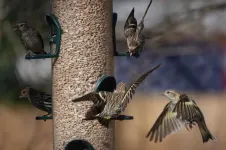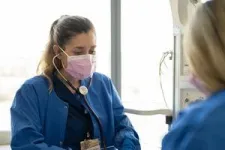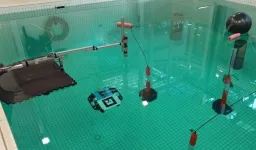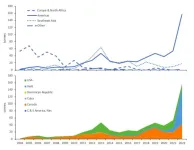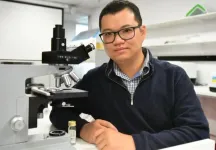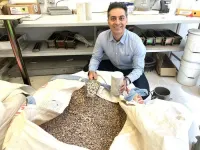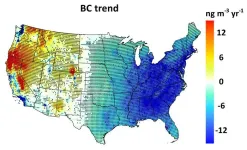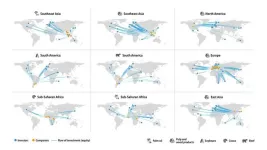(Press-News.org) Ashley Dayer hopes to peck away at the notion that bird feeding is simply for the birds.
Associate professor in the Department of Fish and Wildlife Conservation at Virginia Tech, Dayer is the lead author of an article published in People and Nature that argues not only for the acknowledgment of the activity’s benefit to humans, but that it should play a role in public guidance and policy.
“Wildlife agencies and others making decisions on managing bird feeding need to be considering not only what the science is behind what’s going on with birds, but also the science behind what’s going on with people,” Dayer said.
The article also encourages additional research to better understand how human well-being is impacted by regularly feeding birds, and Dayer and a team of researchers both in and outside of Virginia Tech are leading the way. The group is conducting what is perhaps the first large-scale bird feeding research that also incorporates observing humans.
“People are not only reporting what they see at their bird feeders, but also their emotional responses to it,” Dayer said. “It’s pretty fun because most citizen science projects focus just on the natural or physical science, but we’re now able to look at the human piece of it.”
Funded recently as part of a more than $1.5 million National Science Foundation grant led by Dayer and Dana Hawley, professor of biological sciences, the four-year project aims to engage more than 10,000 bird feeders across the United States.
Other collaborators on the article and project include
Christy Pototsky, a graduate student studying fish and wildlife conservation at Virginia Tech
Richard Hall, associate professor at the University of Georgia
Alia Dietsch, associate professor at Ohio State University
Tina Phillips, David Bonter, Emma Greig, and Wesley Hochachka of the Cornell Lab of Ornithology
Dayer said interest in the topic began in 2021, when the researchers began to notice state agencies advising people to stop feeding birds in response to various avian disease outbreaks. After looking into it, they found that 23 states had made such recommendations without evidence it would decrease disease spread, with varying levels of pushback, and with no real method of gauging compliance, much less its impact on people.
The new project is an extension of the work Dayer and Hawley began about six years ago with the help of a joint seed grant from the Global Change Center of the Fralin Life Sciences Institute and the Institute for Society, Culture, and the Environment.
Hawley said the lack of information about humans related to bird feeing was something she’d not previously considered, and she found it a strong motivator for this project.
“In all my years of studying how bird feeding impacts wild birds, I didn’t give much thought to how it can also impact the people that spend their time and money feeding and watching birds,” Hawley said. “I get calls every year from people who see a sick bird at their feeder and want to know how they can help prevent disease spread. All in all, this made me wonder about how policy decisions that aim to minimize disease spread can inadvertently impact the people who feed the birds.”
To help find those answers, the research team will utilize Project FeederWatch’s existing network of bird enthusiasts. Operated by the Cornell Lab of Ornithology and Birds Canada, FeederWatch has tasked people with asks participants to observe and report what they see at their feeders from November to April for the past 37 years.
“FeederWatch is such a versatile data set even though, at its core, it is based on simple bird counts,” said Emma Greig, co-author and project leader for FeederWatch. “When you overlay information about behavior, disease, habitat, and climate change with those bird counts, we can get amazing insights into ecology and evolution.”
During this project, FeederWatch participants also will be asked to observe their own well-being. Dayer said about 8,000 submissions came in in from the first week of this season alone.
Such passion for birds is something Dayer understands very well. She said her mother always made sure they had bird feeders outside their family’s home, and when she became an “empty nester,” the birds became almost like children.
“She’ll go on vacation and cut the vacation short because she needs to go home and feed her birds,” Dayer said. “So I’ve lived with someone who was really into bird feeding and have seen how important it can be to them.”
But Dayer believes the positive impact of bird feeding isn’t limited to enthusiasts and is important in proving one of the most widely accessible connection to wildlife.
“People in urban areas can feed birds. People with just a deck can feed birds. People with a wide range of physical abilities can feed birds. So it’s just a great way to keep that human connection to wildlife,” Dayer said.
Hawley agreed with that sentiment, and said she hopes their work helps advance policies that will foster both health and healthy relationships.
“In a world where so many of us live in cities or suburbs, having birds visit feeders in our yards or on our balconies is one of the only ways we get to connect daily with wildlife. But people want to be able to feed birds in ways that keep wild bird populations healthy and thriving,” Hawley said. “Our work will ideally help us develop guidelines for bird feeding that minimize risk to wild birds and maximize the benefits to the people that feed them.”
The Department of Fish and Wildlife Conservation is in the College of Natural Resources and Environment. The Department of Biological Sciences is in the College of Science.
END
Bird feeding may give humans something to chirp about
A team of researchers at Virginia Tech and beyond is working to develop a deeper understanding of the relationship between bird feeding and human well-being
2023-12-05
ELSE PRESS RELEASES FROM THIS DATE:
Using AI to find microplastics
2023-12-05
An interdisciplinary research team from the University of Waterloo is using artificial intelligence (AI) to identify microplastics faster and more accurately than ever before.
Microplastics are commonly found in food and are dangerous pollutants that cause severe environmental damage – finding them is the key to getting rid of them.
The research team’s advanced imaging identification system could help wastewater treatment plants and food production industries make informed decisions ...
Eco-friendly glue breakthrough designed by Cal Poly chemistry team receives patent
2023-12-05
An innovative, ecofriendly glue designed by a Cal Poly chemistry research team in collaboration with an East Coast company has been approved for a U.S. government patent.
The patent, approved Nov. 21, creates a pathway for proprietary commercial production of the glue innovation under the direction of the Massachusetts-based company Geisys Ventures with involvement of Cal Poly chemistry faculty and students in research and development as part of a memorandum of understanding between the university and Geisys. The new adhesive has potential to reduce landfill waste and positively impact the environment on a broad scale.
The product, to be formally commercialized under the ...
Underwater vehicle AI model could be used in other adaptive control systems
2023-12-05
Unmanned Underwater Vehicles (UUVs) are used around the world to conduct difficult environmental, remote, oceanic, defence and rescue missions in often unpredictable and harsh conditions.
A new study led by Flinders University and French researchers has now used a novel bio-inspired computing artificial intelligence solution to improve the potential of UUVs and other adaptive control systems to operate more reliability in rough seas and other unpredictable conditions.
This innovative approach, using the Biologically-Inspired Experience Replay (BIER) method, has been published by the Institute of Electrical and Electronics Engineers journal IEEE Access.
Unlike conventional ...
Sugar permeation discovered in plant aquaporins
2023-12-05
Aquaporins, which move water through membranes of plant cells, were not thought to be able to permeate sugar molecules, but University of Adelaide researchers have observed sucrose transport in plant aquaporins for the first time, challenging this theory.
The finding, made by researchers from the School of Agriculture, Food and Wine, widens the concept of aquaporins’ role in plant biology and will have implications for the bioengineering of plants for food production and plant survival.
Aquaporins, which belong to a class of membrane ...
American Eel as an emerging consumer target
2023-12-05
Research led by Hiromi Shiraishi, researcher at Chuo University, indicated a steep rise in the importation of American Eel (Anguilla rostrata) live fry to East Asia for aquaculture purposes. This surge poses a potential threat to the already endangered species, further depleting the resources of this species. Japan relies on imports for two-thirds of its eel consumption and it is believed that a significant quantity of American Eel is included in these imports. As a major consumer of eels, Japan is urged to take a leading role in ensuring the sustainable utilisation of eel species, including ...
New implants linked to less infection and better recovery from orthopedic surgery
2023-12-05
Superior knee and hip replacements are a step closer after Flinders University and Chinese researchers further test and develop a new orthopedic implant coating which has the strong ability to ward off infection – as well as stimulate bone growth.
The technology, which has been patented after more promising results just detailed in the lead scientific journal Advanced Functional Materials, consists of novel Silver-Gallium (Ag-Ga) nano-amalgamated particles that can be easily applied to medical device surfaces.
“The antibacterial capabilities of compounds derived from silver have been extensively researched. ...
Recycling concrete using carbon can reduce emissions and waste
2023-12-05
Amid the rubble of large-sale earthquake, war or other disaster – and as ageing buildings and infrastructure are replaced – mountains of concrete are often taken to landfill or pounded into rubble for roads.
For a more sustainable approach, Flinders University and The University of Melbourne experts are developing a ‘value add’ for old broken concrete to ‘upcycling’ coarse aggregate to produce a strong, durable and workable concrete using a small amount of a secret ingredient – graphene.
The novel method is gaining ground ...
Wildfires have erased two decades’ worth of air quality gains in western United States
2023-12-05
You need only to remember last summer’s wildfires in the United States and Canada, which fouled the air from coast to coast, to know the effects these blazes can have on the environment and human health.
A new study has tabulated the toll from two decades of wildfires on air quality and human health in the continental U.S. The authors report that from 2000 to 2020, the air has worsened in the western U.S., mainly due to the increase in frequency and ferocity of wildfires causing an increase of 670 premature deaths per year in the region during that time period. Overall, the study’s authors report fires have undercut ...
Powerful financial giants could play vital role in preventing the next pandemic
2023-12-05
Many emerging and re-emerging infectious diseases, especially zoonotic diseases such as ebola or new coronaviruses, emerge as the result of intensified human activities such as deforestation, expansion of agricultural land, and increased hunting and trading of wildlife.
In a new study, published in the scientific journal Lancet Planetary Health, researchers identified public and private companies operating in economic sectors associated with increased risks of emerging and re-emerging infectious diseases.
Where data was available, the researchers analyzed the financial ...
A farsighted approach to tackle nearsightedness #Acoustics23
2023-12-05
SYDNEY, Dec. 5, 2023 – Modern living may be contributing to an epidemic of nearsighted vision and related blindness. By 2050, it is estimated that half the world’s population will suffer from low vision due to myopia, a condition where the eye grows too large and can no longer focus on objects in the distance. Human eyes, honed by evolution to survive in the wild, are ill-adapted to city living, contributing to increased cases of myopia, among other factors.
For decades, researcher Sally McFadden from the University of Newcastle has investigated eyes and eyesight in ...
LAST 30 PRESS RELEASES:
New study overturns long-held model of how plants coordinate immune responses.
New AI model predicts disease risk while you sleep
Scientists discover molecular ‘reshuffle’ and crack an 80-year-old conundrum
How stressors during pregnancy impact the developing fetal brain
Electrons lag behind the nucleus
From fungi to brain cells: one scientist's winding path reveals how epigenomics shapes neural destiny
Schizophrenia and osteoporosis share 195 genetic loci, highlighting unexpected biological bridges between brain and bone
Schizophrenia-linked genetic variant renders key brain receptor completely unresponsive to both natural and therapeutic compounds
Innovative review reveals overlooked complexity in cellular energy sensor's dual roles in Alzheimer's disease
Autism research reframed: Why heterogeneity is the data, not the noise
Brazil's genetic treasure trove: supercentenarians reveal secrets of extreme human longevity
The (metabolic) cost of life
CFRI special issue call for papers: New Frontiers in Sustainable Finance
HKU Engineering scholar demonstrates the smallest all-printed infrared photodetectors to date
Precision empowerment for brain "eavesdropping": CAS team develops triple-electrode integrated functional electrode for simultaneous monitoring of neural signals and chemical transmitters during sleep
Single-capillary endothelial dysfunction resolved by optoacoustic mesoscopy
HKU three research projects named among ‘Top 10 Innovation & Technology News in Hong Kong 2025’ showcasing excellence in research and technology transfer
NLRSeek: A reannotation-based pipeline for mining missing NLR genes in sequenced genomes
A strand and whole genome duplication–aware collinear gene identification tool
Light storage in light cages: A revolutionary approach to on-chip quantum memories
Point spread function decoupling in computational fluorescence microscopy
BacPhase: Long-insert paired-end sequencing for bin marker construction and genome phasing
GmWOX1 regulates the mediolateral polarity of compound leaves in soybean
ChargeFabrica: An open-source simulation tool that aims to accelerate search for high performance perovskite solar cells
High levels of ADAR overexpression induce abundant and stochastic off-target RNA editing in rice protoplasts
On-demand upgraded recycling of polyethylene and construction of sustainable multifunctional materials based on the "LEGO" strategy
New "Stomata in-sight" system allows scientists to watch plants breathe in real-time
Anorexia nervosa may result in long-term skeletal muscle impairment
Narrative-based performance reviews deemed fairest by employees
New insights reveal how advanced oxidation can tackle emerging water pollutants
[Press-News.org] Bird feeding may give humans something to chirp aboutA team of researchers at Virginia Tech and beyond is working to develop a deeper understanding of the relationship between bird feeding and human well-being
